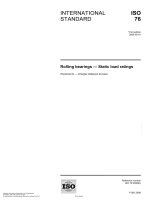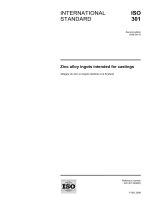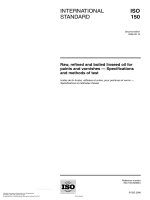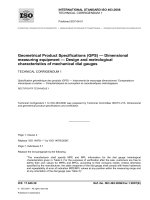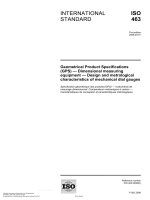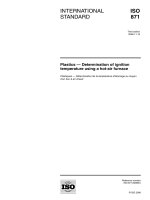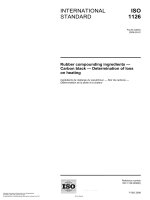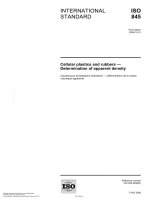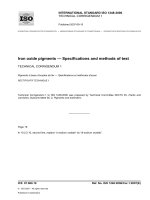Tiêu chuẩn iso 16149 2006
Bạn đang xem bản rút gọn của tài liệu. Xem và tải ngay bản đầy đủ của tài liệu tại đây (150.96 KB, 14 trang )
INTERNATIONAL
STANDARD
ISO
16149
First edition
2006-02-15
Matériel agricole d'irrigation — Tube en PVC, posé au-dessus du sol et
utilisé avec basse pression pour l'irrigation en surface — Spécifications
et méthodes d'essai
Reference number
ISO 16149:2006(E)
Copyright International Organization for Standardization
Provided by IHS under license with ISO
No reproduction or networking permitted without license from IHS
© ISO 2006
Not for Resale
--`,,```,,,,````-`-`,,`,,`,`,,`---
Agricultural irrigation equipment —
PVC above-ground low-pressure pipe
for surface irrigation — Specifications
and test methods
ISO 16149:2006(E)
PDF disclaimer
This PDF file may contain embedded typefaces. In accordance with Adobe's licensing policy, this file may be printed or viewed but
shall not be edited unless the typefaces which are embedded are licensed to and installed on the computer performing the editing. In
downloading this file, parties accept therein the responsibility of not infringing Adobe's licensing policy. The ISO Central Secretariat
accepts no liability in this area.
Adobe is a trademark of Adobe Systems Incorporated.
--`,,```,,,,````-`-`,,`,,`,`,,`---
Details of the software products used to create this PDF file can be found in the General Info relative to the file; the PDF-creation
parameters were optimized for printing. Every care has been taken to ensure that the file is suitable for use by ISO member bodies. In
the unlikely event that a problem relating to it is found, please inform the Central Secretariat at the address given below.
© ISO 2006
All rights reserved. Unless otherwise specified, no part of this publication may be reproduced or utilized in any form or by any means,
electronic or mechanical, including photocopying and microfilm, without permission in writing from either ISO at the address below or
ISO's member body in the country of the requester.
ISO copyright office
Case postale 56 • CH-1211 Geneva 20
Tel. + 41 22 749 01 11
Fax + 41 22 749 09 47
Web www.iso.org
Published in Switzerland
ii
Copyright International Organization for Standardization
Provided by IHS under license with ISO
No reproduction or networking permitted without license from IHS
© ISO 2006 – All rights reserved
Not for Resale
ISO 16149:2006(E)
Foreword
ISO (the International Organization for Standardization) is a worldwide federation of national standards bodies
(ISO member bodies). The work of preparing International Standards is normally carried out through ISO
technical committees. Each member body interested in a subject for which a technical committee has been
established has the right to be represented on that committee. International organizations, governmental and
non-governmental, in liaison with ISO, also take part in the work. ISO collaborates closely with the
International Electrotechnical Commission (IEC) on all matters of electrotechnical standardization.
International Standards are drafted in accordance with the rules given in the ISO/IEC Directives, Part 2.
The main task of technical committees is to prepare International Standards. Draft International Standards
adopted by the technical committees are circulated to the member bodies for voting. Publication as an
International Standard requires approval by at least 75 % of the member bodies casting a vote.
Attention is drawn to the possibility that some of the elements of this document may be the subject of patent
rights. ISO shall not be held responsible for identifying any or all such patent rights.
--`,,```,,,,````-`-`,,`,,`,`,,`---
ISO 16149 was prepared by Technical Committee ISO/TC 23, Tractors and machinery for agriculture and
forestry, Subcommittee SC 18, Irrigation and drainage equipment and systems.
iii
© ISO 2006 – All rights reserved
Copyright International Organization for Standardization
Provided by IHS under license with ISO
No reproduction or networking permitted without license from IHS
Not for Resale
--`,,```,,,,````-`-`,,`,,`,`,,`---
Copyright International Organization for Standardization
Provided by IHS under license with ISO
No reproduction or networking permitted without license from IHS
Not for Resale
INTERNATIONAL STANDARD
ISO 16149:2006(E)
Agricultural irrigation equipment — PVC above-ground
low-pressure pipe for surface irrigation — Specifications
and test methods
1
Scope
This International Standard specifies the requirements for unplasticized polyvinyl chloride (PVC) piping, used
to supply and to distribute low-pressure irrigation water through gates. lt is applicable to PVC piping with
diameters of from 50 mm to 315 mm, operating at low pressures and exposed to sunlight.
2
Normative references
The following referenced documents are indispensable for the application of this document. For dated
references, only the edition cited applies. For undated references, the latest edition of the referenced
document (including any amendments) applies.
ISO 1167-1, Thermoplastics pipes, fittings and assemblies for the conveyance of fluids — Determination of
the resistance to internal pressure — Part 1: General method
ISO 1167-2, Thermoplastics pipes, fittings and assemblies for the conveyance of fluids — Determination of
the resistance to internal pressure — Part 2: Preparation of pipe test pieces
ISO 2505 (all parts), Thermoplastics pipes — Longitudinal reversion
--`,,```,,,,````-`-`,,`,,`,`,,`---
ISO 2507-1, Thermoplastics pipes and fittings — Vicat softening temperature — Part 1: General test method
ISO 2507-2, Thermoplastics pipes and fittings — Vicat softening temperature — Part 2: Test conditions for
unplasticized poly(vinyl chloride) (PVC-U) or chlorinated poly(vinyl chloride) (PVC-C) pipes and fittings and
for high impact resistance poly (vinyl chloride) (PVC-HI) pipes
ISO 9852, Unplasticized poly(vinyl chloride) (PVC-U) pipes — Dichloromethane resistance at specified
temperature (DCMT) — Test method
3
Terms and definitions
For the purposes of this document, the following terms and definitions apply.
3.1
bell
receiving shape at one end of a section of pipe that serves as a watertight seal when the spigot end of an
adjoining pipe section is inserted into the bell
3.2
bevel
smoothed annular and angular area at the end of the spigot for assisting in the coupling of the bell and spigot
joint
1
© ISO 2006 – All rights reserved
Copyright International Organization for Standardization
Provided by IHS under license with ISO
No reproduction or networking permitted without license from IHS
Not for Resale
ISO 16149:2006(E)
3.3
dichloromethane resistance
resistance following exposure to dichloromethane in order to give an indication of the level of gelation in the
pipe and of the uniformity of that gelation
3.4
gate
adjustable opening in the pipe which allows water to be released
3.5
impact strength
measure of the brittleness or the toughness of a material
3.6
longitudinal reversion
change in length of a pipe under higher-than-ambient temperature estimated by subjecting a test portion of
pipe immersed in an inert liquid maintained at a temperature of 150 °C for a period of time determined by the
wall thickness of the pipe
3.7
low pressure
pressure less than 100 kPa
3.8
nominal pipe diameter
reference value for the size of a gated pipe approximately equal to the outside diameter of the pipe, rounded
to the nearest millimetre
3.9
spigot
inserting end of a section of pipe in the bell
3.10
vicat softening temperature
temperature at which a standard indenter under a force of 50 N penetrates 1 mm into the surface of a test
piece cut from the wall of a pipe while the temperature is raised at a constant rate of 50 °C/h
3.11
maximum working pressure
highest water pressure at the inlet to a gated pipe unit recommended by the manufacturer to ensure proper
operation
4
Marking
Each pipe shall bear clear and permanent markings, including the following:
a)
name of manufacturer or registered trademark of the manufacturer;
b)
classification code of the material;
c)
nominal diameter;
d)
reference to this International Standard (i.e. ISO 16149);
e)
production code — compound, extruder, year, month, day, shift.
2
Copyright International Organization for Standardization
Provided by IHS under license with ISO
No reproduction or networking permitted without license from IHS
--`,,```,,,,````-`-`,,`,,`,`,,`---
© ISO 2006 – All rights reserved
Not for Resale
ISO 16149:2006(E)
5
Specifications
--`,,```,,,,````-`-`,,`,,`,`,,`---
5.1
General
The product in conformance with this International Standard shall have specifications according to 5.2 to 5.4.
5.2
Dimensions
5.2.1
Outside diameter
The outside diameter and corresponding tolerances shall be in accordance with Table 1.
Table 1 — Outside diameters and corresponding tolerances
Dimensions in millimetres
Nominal diameter
Outside diameter
Tolerance
dn
do
50
50
+ 0,3
75
75
+ 0,4
100
100
+ 0,4
125
125
+ 0,5
160
160
+ 0,5
200
200
+ 0,6
250
250
+ 0,8
315
315
+ 0,9
Other diameters may be manufactured by agreement between user and manufacturer.
5.2.2
Wall thickness
The minimum wall thickness shall be 2,2 mm or the result of the following equation, whichever is the greater:
t=
doP
2S + P
where
t
is the minimum wall thickness in millimetres (mm);
P
is the pressure in kilopascals (kPa);
S
is the design stress in kilopascals (kPa);
do
is the outside diameter, in millimetres (mm).
The wall thickness tolerance shall be + 12 % or 0,8 mm, whichever is the greater.
The dimensions shall be measured according to 8.1.
3
© ISO 2006 – All rights reserved
Copyright International Organization for Standardization
Provided by IHS under license with ISO
No reproduction or networking permitted without license from IHS
Not for Resale
ISO 16149:2006(E)
5.3
5.3.1
Mechanics
Resistance to impact
Select the point of impact to allow for gate stability during the test. The gated pipe shall not break or fracture,
nor shall the gate separate from the pipe, when tested according to 8.2.
The test impact force shall be in accordance with Table 2.
Table 2 — Test impact force
--`,,```,,,,````-`-`,,`,,`,`,,`---
Nominal diameter
dn
NOTE
5.3.2
Impact energy
mm
N⋅m
kg ⋅ m
50
40
4
75
40
4
160
50
5
200
50
5
250
60
6
315
60
6
For practical purposes, 1 kg force is equal to 10 N.
Resistance to crushing
A pipe with gates shall show no breaks, splits or cracks and the gates shall not separate or have permanent
distortion when crushed according to 8.3.
5.3.3
Resistance to accelerated aging (weathering)
The pipes shall have no cracks, bubbles or other defects that could affect their properties when tested under
the conditions according to 8.4.
5.3.4
Watertightness of the joint and of the gate
Test the assembled joints for joint tightness at a pressure of 250 kPa for a period of at least 15 min, under the
conditions according to 8.5. No joint leakage shall occur.
5.4
5.4.1
Physics and chemistry
Resistance to dichloromethane
When tested in accordance with 8.6, the tested pipe wall shall resist attack in 100 % of internal and external
surfaces and in the bevelled area.
5.4.2
Longitudinal reversion
When the pipe is tested in accordance with 8.7, the specimen length variation shall be < 5 %. The test section
shall show no bubbles, fissures or opaque areas, or other noticeable defects.
5.4.3
Vicat softening temperature
When the pipe is tested in accordance with 8.8, the Vicat softening temperature shall be > 80 °C.
4
Copyright International Organization for Standardization
Provided by IHS under license with ISO
No reproduction or networking permitted without license from IHS
© ISO 2006 – All rights reserved
Not for Resale
ISO 16149:2006(E)
6
Flow rate of gates
The test flow rate through the gates at the test pressure recommended by the manufacturer shall not vary by
more than + 10 % of that specified by the manufacturer, measured in accordance with 8.9.
NOTE
7
This specification is applicable to pipes subjected to a pressure higher than the atmospheric pressure.
Sampling and acceptance number
See Table 3.
Clause/subclause
of this International
Standard
Number
of test specimens
Acceptance
number
Marking
13
0
Dimensions
13
0
5.3.1
Resistance to impact
5
0
5.3.2
Resistance to crushing
5
0
5.3.3
Resistance to accelerated aging
5
0
5.3.4
Watertightness of the joint and the gate
5
0
5.4.1
Resistance to dichloromethane
5
0
5.4.2
Longitudinal reversion
5
0
5.4.3
Vicat softening temperature
5
0
Flow rate of gates
13
0
4
5.1
6
8
Test
--`,,```,,,,````-`-`,,`,,`,`,,`---
Table 3 — Acceptance number
Tests
8.1
8.1.1
Measurement of dimensions
General
The precision required in each measurement is 0,025 mm.
8.1.2
Wall thickness
Measure the wall thickness using a micrometer with ball anvil or other measuring instrument having the same
precision.
8.1.3
Outside diameter
Ensure that the outside diameter is measured with a slide calliper and the readings rounded off to the nearest
0,1 mm. Take measurements around the same cross-section, perpendicular to the pipe axis, rotating the
callipers in the plane of this cross-section until the maximum and minimum values are found.
5
© ISO 2006 – All rights reserved
Copyright International Organization for Standardization
Provided by IHS under license with ISO
No reproduction or networking permitted without license from IHS
Not for Resale
ISO 16149:2006(E)
8.2
Resistance to impact
Ensure that a tup impact tester with a tup-type B nose is used (radius, 50 mm). Ensure that the specimen is at
least equal in length to the nominal outside diameter but not less than 150 mm. Condition the test specimens
at 23 ± 2 °C and 50 ± 5 % relative humidity for not less than 40 h prior to test. For equipment and procedure
details, see Reference [6].
8.3
Resistance to crushing
Ensure that the length of the specimens includes at least one gate near the centre. Crush specimens between
parallel plates in a suitable press until the distance between plates is 40 % of the outside diameter of the pipe.
Ensure that the rate of loading is uniform and such that the compression is completed within 2 min to 5 min.
See also Reference [5].
8.4
Resistance to accelerated aging (weathering)
8.5
Watertightness of the joint and the gate
Ensure that a cylindrical container type of end cap fitted with adequate temperature and pressure equipment
is used to maintain a temperature of 23 ± 2 °C and the pressure according to 5.3.4. Calculate the length of the
test pieces from the following equations.
For a diameter less than 250 mm:
L = 250 + 3 d o + X
For diameters equal or greater than 250 mm:
L = 1 000 + 2 X
where
L
is the length of the piece test in millimetres (mm);
do
is the outside diameter in millimetres (mm);
X
is the length between end caps of the container in millimetres (mm).
For equipment and procedure details, see ISO 1167-1 and ISO 1167-2.
8.6
Resistance to dichloromethane
Ensure that a container made of stainless steel is used and that it has a capacity suitable to contain both the
dichloromethane and the test piece, that it is fitted with equipment suitable for suspending the test piece, and
that it is provided with a device for temperature control, capable of maintaining the temperature of the
dichloromethane at 20 °C ± 1 °C for 15 min. Remove test pieces at least 100 mm long from the pipe to be
tested for resistance to dichloromethane. The equipment and procedure used shall be in accordance with
ISO 9852.
8.7
Longitudinal reversion
Use a container with an inert liquid maintained at a temperature of 150 °C ± 2 °C for a period determined in
relation to the wall thickness of the pipe, as specified in ISO 2505. The length of the test specimens shall be
200 mm ± 20 mm. The equipment and procedure used shall be in accordance with ISO 2505.
6
Copyright International Organization for Standardization
Provided by IHS under license with ISO
No reproduction or networking permitted without license from IHS
© ISO 2006 – All rights reserved
Not for Resale
--`,,```,,,,````-`-`,,`,,`,`,,`---
Ensure that the specimen thickness is < 20 mm. Mount the test specimens in the specimen rack with the test
surfaces facing the lamp. When the test specimens do not completely fill the racks, fill the empty spaces with
blank panels. Use a cycle and a temperature as follows: 4 h UV at 60 °C, and condensation at 50 °C. For
equipment and procedure details, see Reference [6].
ISO 16149:2006(E)
8.8
Vicat softening temperature
--`,,```,,,,````-`-`,,`,,`,`,,`---
This test consists of immersing segments of rings removed from the pipes, having a length of approximately
50 mm, a width of between 10 mm and 20 mm and a thickness of between 2,4 mm and 6 mm, in a heating
bath containing a suitable liquid. Then determine the temperature at which a standard indenter penetrates
1 mm + 0,01 mm into the test piece (see Figure 1). The equipment and procedure used shall be in accordance
with ISO 2507-1 and ISO 2507-2.
Key
1
dial gauge micrometer
2
interchangeable weight
3
assembly of rod and indenting tip supporting the load-carrying plate
4
approx. level of liquid
5
indenting tip
6
test specimen
Figure 1 — Equipment and location of test specimen for Vicat softening temperature test
8.9
Flow rate of gates
Measure the flow rate in the first and the last gates of the lateral pipe, following the manufacturer’s
recommendations for pressure and degree of gate opening, as well as for any other parameters that the
manufacturer considers necessary.
7
© ISO 2006 – All rights reserved
Copyright International Organization for Standardization
Provided by IHS under license with ISO
No reproduction or networking permitted without license from IHS
Not for Resale
ISO 16149:2006(E)
Bibliography
ISO 3126, Plastics pipes — Measurement of dimensions
[2]
ISO 3951, Sampling procedures and charts for inspection by variables for percent nonconforming
[3]
NMX-E-234-SCFI-2001, Plastic industry — PVC piping — Unplasticized polyvinyl chloride (PVC) pipes
for irrigation low-pressure water supply with gates — Specifications 1)
[4]
ASTM2) G 53, Standard Test Method for Operating Light-Exposure and Water-Exposure Apparatus
(Fluorescent UV–Condensation-Type) for Nonmetallic Materials
[5]
ASTM D 2441-89, Standard Test Method for Polyvinyl Chloride (PVC) Pressure-Rated Pipe
[6]
ASTM D 2444-99, Standard Test Method for Impact Resistance of Thermoplastic Pipe and Fittings by
Means of a Tup (Falling Weight)
--`,,```,,,,````-`-`,,`,,`,`,,`---
[1]
1)
Mexican Standard (NMX).
2)
American Society for Testing and Materials.
8
Copyright International Organization for Standardization
Provided by IHS under license with ISO
No reproduction or networking permitted without license from IHS
© ISO 2006 – All rights reserved
Not for Resale
--`,,```,,,,````-`-`,,`,,`,`,,`---
Copyright International Organization for Standardization
Provided by IHS under license with ISO
No reproduction or networking permitted without license from IHS
Not for Resale
ISO 16149:2006(E)
--`,,```,,,,````-`-`,,`,,`,`,,`---
ICS 65.060.35
Price based on 8 pages
© ISO 2006 – All rights reserved
Copyright International Organization for Standardization
Provided by IHS under license with ISO
No reproduction or networking permitted without license from IHS
Not for Resale
